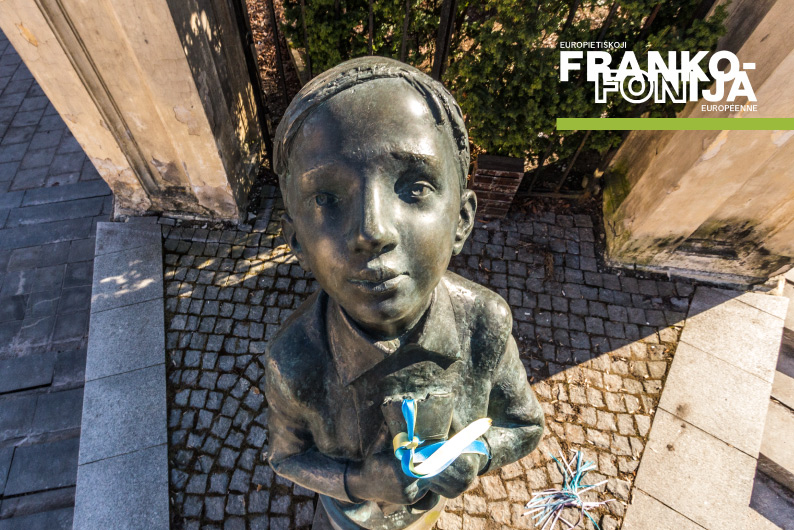

 18 March 2022
18 March 2022
The exhibition “Romain Gary: Back to Vilnius” (French: Romain Gary: un retour à Vilnius) aims to introduce the public to the literary work and life of a prominent writer Romain Gary (1914–1980). Romain Gary has long been an important part of the multicultural history of Vilnius, and as a true humanist who was committed to the struggle for freedom, he could not be more relevant in today’s tumultuous world when democracy and humanist values are under threat.
The exhibition features some of R. Gary’s first publications (published in London during the war), original editions of his most important works which he wrote under the name Romain Gary or under his pen name Émile Ajar, revealing his multifaceted talent across multiple genres as well as his strong commitment to values that give meaning to life, which for him was a strange and wonderful, confusing and dramatic adventure.
Romain Gary (original name Roman Kacew) was a multifaceted figure. His life transcended that of a “lyrical clown” who, by creating different characters, tried to live multiple lives at one time and tried “all the things that life has to offer” before he took his last breath. When history took a dramatic turn with the outbreak of World War II, he also devoted himself to fighting for freedom to save “the only important thing that mattered, the Human”.
General Charles de Gaulle awarded him the Cross of Liberation for his determination to fight Nazism and his heroic service as an aviator of the Free French Forces (Lorraine Squadron). The Cross of Liberation is a very high honour awarded to fighters and fighter organisations with slightly more than one thousand recipients ever awarded. This exhibit presented at the exhibition should serve as a reminder of his inspiring courage and how he risked his life in the struggle for common human values and for human dignity which was under the threat of being trampled on.
The exhibition “Romain Gary: Back to Vilnius” speaks to all members of the general public: to those who are interested in the dramatic history of Europe in the 20th century when Lithuania and its capital Vilnius fell into the hands of different occupying forces, to those who would like to rediscover R. Gary, a world-renowned writer who explored the issues that are currently so relevant in his works, and, of course, to school pupils, students and young people in general who, looking beyond a strange and frivolous guise of a “writer-chameleon”, will be able to discover an inspiring aspiration for Freedom.
The exhibition focuses on the writer’s relationship with two people who, according to R. Gary himself, guided him and fundamentally influenced the trajectory of his later years: André Malraux, writer and France’s first Minister of Cultural Affairs who was among the first ones to notice and appreciate R. Gary’s talent, and General Charles de Gaulle who “embodied the spirit of France”. The Lithuanian audience are well familiar with the importance of the writer’s mother in his life from his autobiographical novel Promise at Dawn (La Promesse de l’aube, 1960) as well as from his other texts.
The exhibition also provides a retrospective glance at the cityscape of Vilnius in the early 20th century: the buildings, the expanding street network, the socio-cultural life, and the press of that time. The photos, newspaper clippings and other exhibits and stories aim to partially recreate and introduce the public to the everyday life and atmosphere of Vilnius at that time, which R. Gary experienced himself and later immortalized in his novel Promise at Dawn.
The organisers of the exhibition, Vilnius University and the Martynas Mažvydas National Library of Lithuania, would like to express their gratitude to the sponsors and partners of the exhibition who helped to bring, in a symbolic sense, R. Gary back to Vilnius: Embassy of the Republic of Lithuania in the French Republic, French Institute in Lithuania, the Liberation of Paris Museum, Alytus Adolfas Ramanauskas-Vanagas Gymnasium, and Mr. Jean-René Bourrel, scholar researching R. Gary and André Malraux.
We would also like to extend our gratitude to the Lithuanian State Historical Archives and the Lithuanian Central State Archives for their cooperation in supporting this exhibition with important archival documents.
The exhibition will be on display from 23 March to 24 April at the Education Lab (5th floor) of the National Library. The opening of the exhibition will be held on 23 March at 4:00 pm in the Atrium of the National Library, 5th floor. The exhibition is part of the Francophonie Days program.
Image used: “A Boy with A Galoshe”, sculpture by Romuladas Kvintas, 2007, LATGA, 2022. Photo by Arūnas Sartanavičius.



